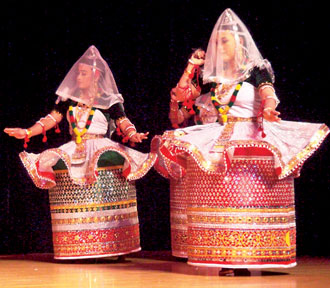Manipuri, the most graceful dance among Indian classical dances
By Subashini Pathmanathan
The East Indian state dance Manipuri gained worldwide recognition.
Manipuri originated in the East Indian state of Manipur. The word
Manipuri is also often used for Manipuri saris. The excellent Manipuri
saris are also manufactured in the Manipur state of India.
In the Manipuri dance the Rasa Lila, dances are deeply linked to
devotional worship, and were earlier performed in the temples. The
dances were performed at the Nat Mandapas in the temples of Manipur.
 |
|
Manipuri dancers |
The Manipuri dance as all other Indian classical dance forms has its
roots, in deep devotion, and spiritualism. King Bhagaya Chandra was a
famous king who ruled Manipur during the period 1759 to 1798 A.D. He was
deeply involved in culture and religion.
Dance and music
He excelled in prose, poetry, philosophy, dance, drama, and music.
The kings and the queens were very much involved, with the traditional
art forms, mainly dance and music.
The queen herself danced with the public, in the same public places,
and the common masses were not restrained from seeing the performances.
Generally, the dance was common to all; there was no barrier for caste
or creed.
The dance was not practised merely for entertainment, but with a deep
dedication and devotion. After the era of king Bhagaya Chandra, the
kings in his lineage, gave their support and patronised the dance and
other art forms.
Even the development of Thalas in Manipuri is still identified with
the rule and period of individual kings. The male dancers play an
equally important role with female dancers.
The male Manipuri dancers generally carry a different variety and
shapes of drums, when they dance. Sometimes while dancing they carry
large cymbals (which are called Kartaal).
The male Manipuri dancers generally wear white dhotis, and often wear
white turbans. It is a distinct feature of the Manipuri male dancers as
compared to male dancers of the other Indian classical dances.
Ornaments
They hardly wear any ornaments and not even ankle bells. The Manipuri
dance form is entirely different from the other classical state dances
of India.
The females dancers wear beautiful, specially designed costumes.
Long, stiff embroidered skirts are worn by the female dancers, and round
stiff bamboo sticks are kept in place to keep the skirts firm and stiff.
The costumes are of an extraordinary pattern as distinguished from the
other Indian dance costumes.
The movements of the Manipuri dance are smooth and free flowing,
though the thandava and Lassiya aspects could be seen in this
traditional dance form. Bengali and Manipuri languages are used in the
Manipuri dance.
The poetic verses are derived from Jayadeva, Vidyapathy, and
Chandidas and other well-known Manipuri poets.
The Manipuri dance is performed individually or by a group of
individuals. It also uses the hastas to some extent but not as in other
classical Indian dances. A comparative study of the Manipuri with
Bharatha Natyam reveals that the Manipuri like the Bharatha Natyam uses
thandava and lassiya together.
In Bharatha Natyam Angika Abinaya, (communication of movements
through body limbs such as Anga, Upangas, and Prathiangas), Akariya
Abhinaya (usage of dresses costumes and make up), Vaachika Abhinaya
(interpretation of the songs through words), and Sathvika Abinaya
(expresses the emotions through Abhinaya with involvement, or expresses
through the inner feeling) are equally used.
But in the Manipuri, Angika Abhinaya and Akaariya Abhinaya are
equally used. But there is little scope for Vaachika Abhinaya
(interpretation of the songs through words), and there is no scope at
all for Saathvika Abhinayas (expresses the emotions through Abhinaya
with involvement, or expresses through the inner feeling).
Like the Kathak and Kathakali, male dancers play a major role in the
Manipuri. Dolki a special drum is carried by the male dancers while
dancing.
Female dancers allow the hands to flow freely and gracefully, but the
usage of hand gestures are limited. Like the Bharatha Natyam, Manipuri
is also based on Hinduism, including Sivaism and Vishnavaism.
The Manipuri is a unique and graceful dance form compared to other
Indian classical dance forms. |

